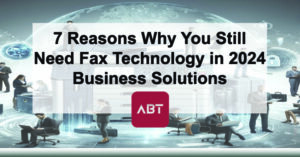
Digital Fax vs. Analog Fax: Which Is Right for Your Business in 2024?
Faxing is far from dead—especially in industries like healthcare, law, and finance where secure document exchange is non-negotiable. But as technology evolves, so does the way we send documents. Today, many Colorado businesses are considering whether to stick with analog faxing or shift to more modern digital fax solutions.
In this guide, we break down the key differences between digital and analog fax systems to help you decide which is the smarter move for your workflow, budget, and compliance needs.
What Is Analog Fax?
Analog fax uses the Public Switched Telephone Network (PSTN) to transmit documents. A physical fax machine scans your document, converts it into analog signals, and sends it over a landline to another fax machine, which then prints the document.
Advantages of Analog Fax
- Simplicity: It’s familiar and easy to operate.
- No Internet Required: Keeps working during internet outages.
- Hardware Compatibility: Legacy equipment is still in wide use.
Disadvantages of Analog Fax
- High Maintenance Costs: Requires paper, toner, maintenance, and landlines.
- Scalability Limits: Adding capacity means more hardware and phone lines.
- Security Risks: Paper faxes can be intercepted or misdelivered.
- Image Degradation: Analog faxes often lose resolution.
What Is Digital Fax?
Digital fax—also known as cloud-based faxing—sends electronic documents via the internet. It converts your file (PDF, image, doc) into a secure transmission that arrives via email, web portal, or compatible MFP. No landlines or physical fax machines required.

Advantages of Digital Fax
- Lower Costs: No phone lines, toner, or dedicated hardware.
- Highly Scalable: Add users, not machines or lines.
- Enhanced Security: Encrypted transmissions and access controls.
- Cloud Integration: Sync with Google Drive, Dropbox, or SharePoint.
- Remote Friendly: Fax from anywhere using any device.
- High Resolution: No quality loss on scanned or digital faxes.
Disadvantages of Digital Fax
- Requires Internet: No service during outages without backup.
- Learning Curve: Some staff may need onboarding.
- Legacy Compatibility: May require bridging if partners still use analog fax.

Comparison: Digital Fax vs. Analog Fax
| Feature | Analog Fax | Digital Fax |
|---|---|---|
| Transmission Method | PSTN (Phone Line) | Internet / Cloud |
| Hardware | Fax machine required | None; software or MFP only |
| Cost | High (lines, toner, paper) | Low (no consumables) |
| Security | Unencrypted, vulnerable | Encrypted and secure |
| Access | Office-only | Anywhere with internet |
| Image Quality | Low-resolution | High-resolution digital |
| Scalability | Limited by hardware | Instantly scalable |
When Should You Use Digital Fax?
- You’re growing or remote and need secure faxing on the go.
- You want to reduce infrastructure costs.
- You operate in regulated industries (HIPAA, GDPR).
- You require seamless workflow integration with cloud apps.
When Is Analog Fax Still Useful?
- You have no internet or frequent outages.
- Your clients still use fax machines exclusively.
- You already have legacy systems in place and replacing them isn’t urgent.
How ABT Helps You Transition to Digital Fax
ABT helps Colorado businesses modernize their communications with workflow-optimized technology like secure digital fax. We’ll evaluate your current setup, recommend the right solutions, and walk you through setup and staff training.
Why Choose ABT?
- Expert Guidance: We assess your infrastructure and goals.
- Smooth Deployment: Full migration support from analog to digital.
- Ongoing Support: Local, responsive assistance when you need it.
- Security & Compliance: We help you stay protected and audit-ready.
💡 Ready to Upgrade Your Faxing Solution?
Let ABT help you make the transition to secure, cloud-based faxing. Contact our Colorado team at (303) 778-0600 or schedule a consultation online today.
Say goodbye to outdated tech—and hello to smarter, more secure document workflows. 🚀
